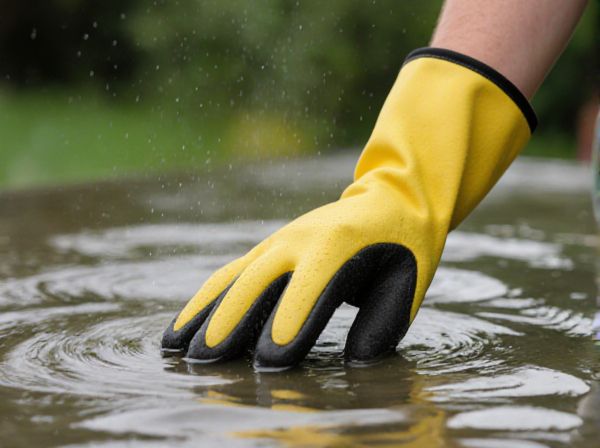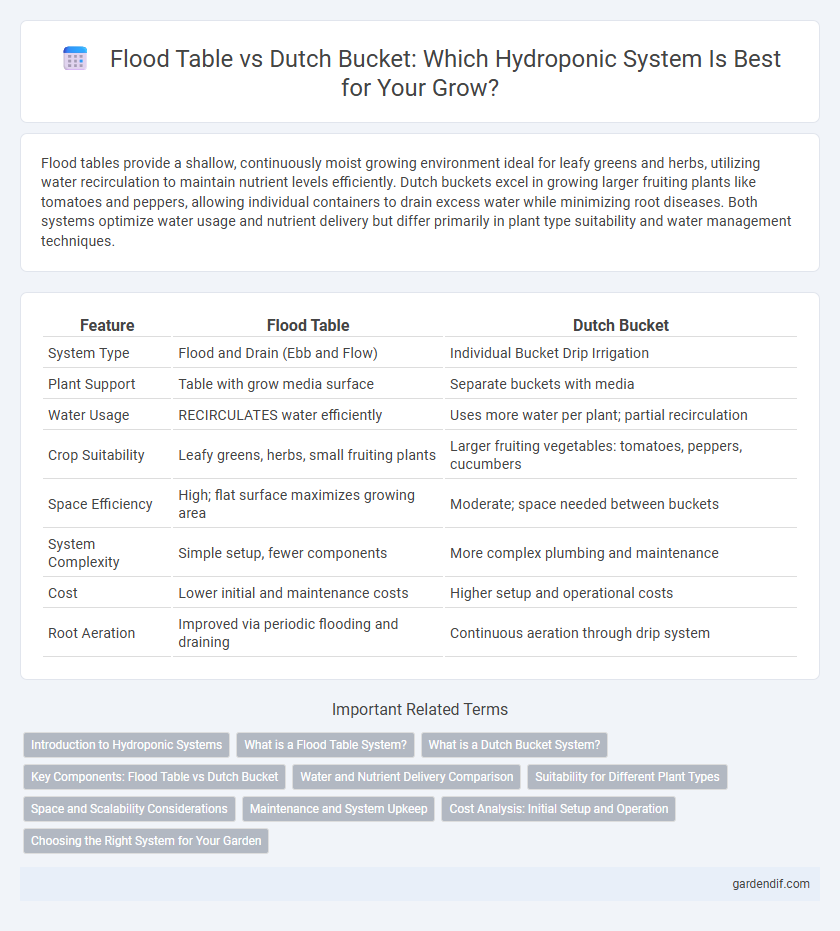
Flood Table vs Dutch Bucket Illustration
Flood tables provide a shallow, continuously moist growing environment ideal for leafy greens and herbs, utilizing water recirculation to maintain nutrient levels efficiently. Dutch buckets excel in growing larger fruiting plants like tomatoes and peppers, allowing individual containers to drain excess water while minimizing root diseases. Both systems optimize water usage and nutrient delivery but differ primarily in plant type suitability and water management techniques.
Table of Comparison
| Feature | Flood Table | Dutch Bucket |
|---|---|---|
| System Type | Flood and Drain (Ebb and Flow) | Individual Bucket Drip Irrigation |
| Plant Support | Table with grow media surface | Separate buckets with media |
| Water Usage | RECIRCULATES water efficiently | Uses more water per plant; partial recirculation |
| Crop Suitability | Leafy greens, herbs, small fruiting plants | Larger fruiting vegetables: tomatoes, peppers, cucumbers |
| Space Efficiency | High; flat surface maximizes growing area | Moderate; space needed between buckets |
| System Complexity | Simple setup, fewer components | More complex plumbing and maintenance |
| Cost | Lower initial and maintenance costs | Higher setup and operational costs |
| Root Aeration | Improved via periodic flooding and draining | Continuous aeration through drip system |
Introduction to Hydroponic Systems
Flood Table systems and Dutch Bucket systems are two popular hydroponic methods designed for efficient nutrient delivery and water conservation. Flood Table systems use a flat tray periodically flooded with nutrient-rich water, ideal for small, leafy greens and delicate plants, while Dutch Bucket systems feature individual containers with drainage, suitable for larger, fruiting crops like tomatoes and cucumbers. Both systems optimize root aeration and nutrient uptake, making them integral to controlled environment agriculture and commercial hydroponic production.
What is a Flood Table System?
A Flood Table System in hydroponics is a method where plants grow on a flat table periodically flooded with nutrient-rich water, ensuring roots receive oxygen and nutrients efficiently. This system supports high-density planting and promotes faster growth by maintaining consistent moisture levels and aeration. Flood tables are ideal for leafy greens and herbs due to their ease of maintenance and scalability.
What is a Dutch Bucket System?
A Dutch Bucket system is a hydroponic method designed for growing larger, vining crops like tomatoes, cucumbers, and peppers by using individual buckets filled with a growing medium. Each bucket drains excess nutrient solution into a common return line, ensuring efficient water and nutrient recirculation while minimizing root disease risks. This system offers precise control over water delivery and aeration, making it ideal for commercial-scale hydroponic farming compared to flood table setups.
Key Components: Flood Table vs Dutch Bucket
Flood tables feature a flat growing surface with a shallow basin that floods with nutrient solution, relying on a pump, timer, and drain system to control water levels. Dutch buckets use individual containers paired with drip irrigation emitters, designed for larger plants, incorporating a drain system to recirculate excess nutrient solution efficiently. Key components of the flood table emphasize uniform flooding and drainage across the entire surface, while Dutch buckets focus on targeted irrigation and drainage for each plant.
Water and Nutrient Delivery Comparison
Flood tables provide uniform water and nutrient delivery by periodically flooding the growing surface, ensuring roots receive consistent moisture and aeration. Dutch buckets utilize a recirculating drip system, delivering precise nutrient solutions directly to each plant's root zone, minimizing water waste. Both systems optimize efficiency, but flood tables excel in oxygenation, while Dutch buckets offer targeted nutrient control.
Suitability for Different Plant Types
Flood tables excel in growing leafy greens and herbs due to their uniform water distribution and shallow root zones, making them ideal for fast-growing, shallow-rooted plants. Dutch buckets provide a better environment for larger fruiting crops like tomatoes and peppers by allowing deeper root development and individual plant irrigation control. Choosing between flood tables and Dutch buckets depends on the specific plant type, root depth, and water needs to optimize growth and yield in hydroponic systems.
Space and Scalability Considerations
Flood tables offer efficient use of horizontal space, making them ideal for large-scale hydroponic farms with uniform crops, while Dutch buckets require more room per plant due to individual containers, limiting density. Scalability in flood tables is straightforward through modular expansion, enabling rapid area increase, whereas Dutch bucket systems scale by adding more buckets, which can complicate water management and system uniformity. Choosing between these methods depends on the grower's available space and long-term scalability goals within hydroponic cultivation.
Maintenance and System Upkeep
Flood tables require regular cleaning to prevent algae buildup and ensure efficient water drainage, while Dutch bucket systems demand consistent monitoring of nutrient solution levels and frequent inspection for clogging in drip emitters. Maintenance for flood tables involves managing the water pump and flood cycles to avoid mechanical failures, whereas Dutch buckets necessitate checking for leaks and maintaining the integrity of individual buckets to prevent root diseases. Both systems benefit from routine sterilization practices to sustain optimal plant health and maximize longevity.
Cost Analysis: Initial Setup and Operation
Flood tables typically require higher initial investment due to complex plumbing and flood control systems but offer efficient water and nutrient recycling, reducing long-term operational costs. Dutch bucket systems have lower upfront costs with simpler setup and maintenance but may increase water use and labor for nutrient solution management, impacting ongoing expenses. Cost-effectiveness varies based on scale, crop type, and resource availability, influencing the choice between the two hydroponic setups.
Choosing the Right System for Your Garden
Flood Table systems offer consistent moisture and oxygenation by periodically flooding growing trays, ideal for leafy greens and herbs requiring shallow root zones. Dutch Bucket systems provide targeted drip irrigation to individual plants, making them suitable for larger fruiting crops like tomatoes and peppers with deeper root structures. Selecting the right system depends on crop type, space availability, and maintenance preferences to optimize growth and resource efficiency.
Flood Table vs Dutch Bucket Infographic

 gardendif.com
gardendif.com